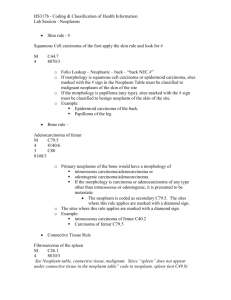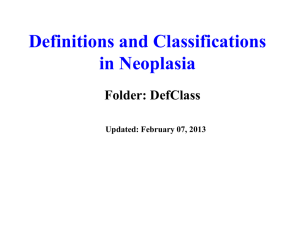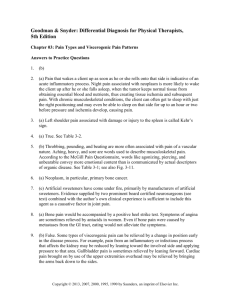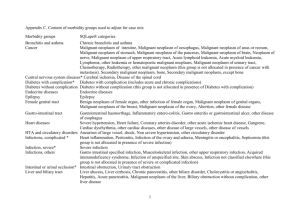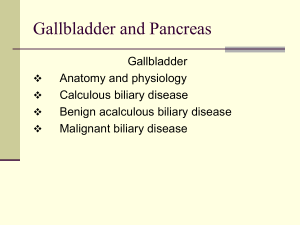01252010text
advertisement
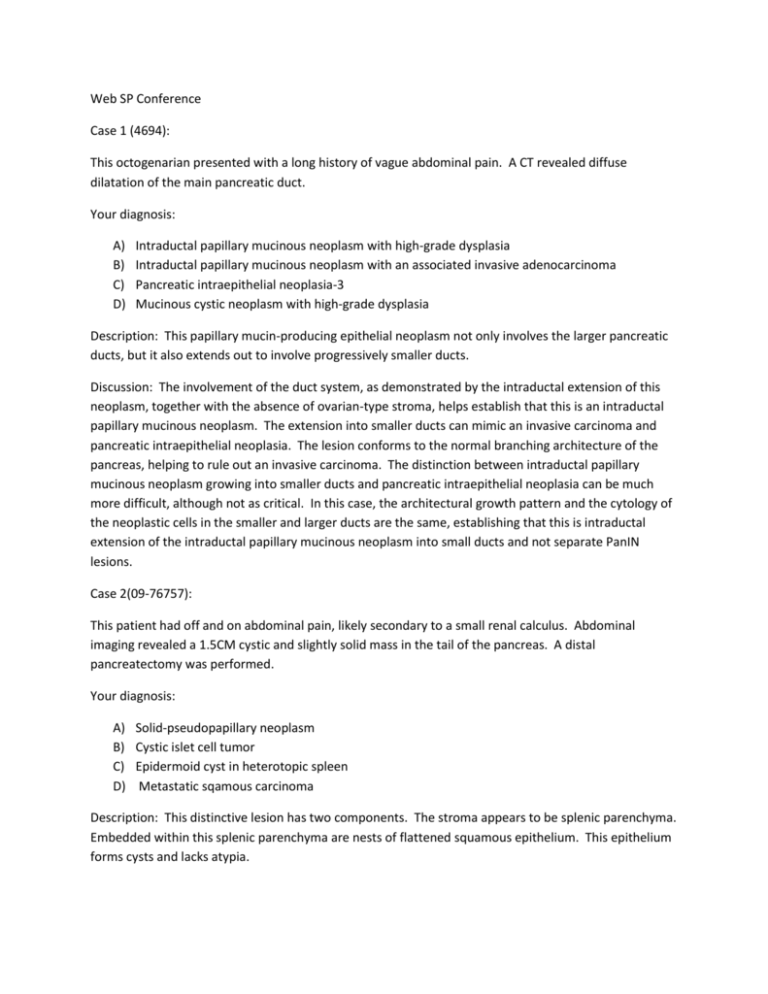
Web SP Conference Case 1 (4694): This octogenarian presented with a long history of vague abdominal pain. A CT revealed diffuse dilatation of the main pancreatic duct. Your diagnosis: A) B) C) D) Intraductal papillary mucinous neoplasm with high-grade dysplasia Intraductal papillary mucinous neoplasm with an associated invasive adenocarcinoma Pancreatic intraepithelial neoplasia-3 Mucinous cystic neoplasm with high-grade dysplasia Description: This papillary mucin-producing epithelial neoplasm not only involves the larger pancreatic ducts, but it also extends out to involve progressively smaller ducts. Discussion: The involvement of the duct system, as demonstrated by the intraductal extension of this neoplasm, together with the absence of ovarian-type stroma, helps establish that this is an intraductal papillary mucinous neoplasm. The extension into smaller ducts can mimic an invasive carcinoma and pancreatic intraepithelial neoplasia. The lesion conforms to the normal branching architecture of the pancreas, helping to rule out an invasive carcinoma. The distinction between intraductal papillary mucinous neoplasm growing into smaller ducts and pancreatic intraepithelial neoplasia can be much more difficult, although not as critical. In this case, the architectural growth pattern and the cytology of the neoplastic cells in the smaller and larger ducts are the same, establishing that this is intraductal extension of the intraductal papillary mucinous neoplasm into small ducts and not separate PanIN lesions. Case 2(09-76757): This patient had off and on abdominal pain, likely secondary to a small renal calculus. Abdominal imaging revealed a 1.5CM cystic and slightly solid mass in the tail of the pancreas. A distal pancreatectomy was performed. Your diagnosis: A) B) C) D) Solid-pseudopapillary neoplasm Cystic islet cell tumor Epidermoid cyst in heterotopic spleen Metastatic sqamous carcinoma Description: This distinctive lesion has two components. The stroma appears to be splenic parenchyma. Embedded within this splenic parenchyma are nests of flattened squamous epithelium. This epithelium forms cysts and lacks atypia. Discussion: Epidermoid cyst in heterotopic spleen is a very rare entity that is important to recognize because it can mimic a neoplasm. The splenic parenchyma gives the diagnosis away. Case 3 (4696): This adult patient with a remote history of a nephrectomy was found to have a hypervascular enhancing solid mass in the pancreas. Your Diagnosis: A) B) C) D) Clear cell well-differentiated endocrine neoplasm Renal cell carcinoma metastatic to the pancreas Solid-pseudopapillary neoplasm Serous cystadenoma Description: This is a solid cellular neoplasm. Immunolabeling for Pax8 was positive. Discussion: A variety of neoplasms in the pancreas can have clear cell features. These include serous cystadenomas, pancreatic endocrine neoplasms (especially in patients with von Hippel Lindau syndrome), metastatic renal cell carcinoma, solid-pseudopapillary neoplasm, and, more rarely clear cell change in an adenocarcinoma. This differential can be particularly problematic in patients with von Hippel-Lindau syndrome, as they are predisposed to develop both renal cell carcinoma and pancreatic endocrine neoplasms with clear cell change. A panel of immunostains is often needed to establish the diagnosis. Pancreatic endocrine neoplasms strongly and diffusely express synaptophysin and chromogranin, solid-pseudopapillary neoplasms express CD10 and have an abnormal nuclear pattern of labeling with antibodies to beta-catenin, renal cell carcinomas express Pax8 and RCC, and serous cystic neoplasms are usually easy to diagnose without stains. Case 4 (09-75895): This adult female patient presented with jaundice. CT revealed a discrete enhancing mass in the head of the pancreas. A Whipple was performed. Your Diagnosis: A) B) C) D) Well-differentiated pancreatic endocrine neoplasm Mixed ductal-endocrine carcinoma Infiltrating adenocarcinoma Ductuloinsular carcinoma Description: This is a solid-cellular neoplasm. Nests of cells with salt and pepper nuclei are admixed with well-differentiated gland-forming epithelial cells. Discussion: The differential diagnosis for solid-cellular neoplasms of the pancreas includes well-differentiated endocrine neoplasms, acinar cell carcinoma, pancreatoblastoma and the solid-pseudopapillary neoplasm. This neoplasm clearly has endocrine looking nuclei and indeed it is a well-differentiated endocrine neoplasm. The admixed glands are unusual. They do not represent a second line of differentiation. Instead, they are trapped non-neoplastic ducts. These ducts are often mis-diagnosed as an adenocarcinoma component (or as “ductuloinsular carcinoma”). The non-neoplastic nature of these ducts can be appreciated by the complete absence of any atypia and by their conforming to the welldefined edges of the endocrine neoplasm. The glands never violate the architecture of the pancreas or the architecture of the well-defined mass. Case 5(09-73672): This adult male patient presented with painless jaundice. . CT revealed diffuse enlargement of the head of the pancreas. A Whipple was performed. Your diagnosis: A) B) C) D) Autoimmine pancreatitis Alcoholic pancreatitis Isletitis in a patient with diabetes Granulomatous pancreatitis Description: Numerous well-formed granulomata are scattered throughout this pancreas. An immunostain for IgG4 revealed only rare IgG4 positive cells. A stain for acid fast bacilli was negative. Discussion: Granulomatous pancreatitis is rare. Granulomata can be found in the pancreas in patients with sarcoidosis, but usually patients have known involvement of other organs. Tuberculosis and other infections that produce granulomata can involve the pancreas. In this case, all special stains for organisms were negative, suggesting that this patient has sarcoid involving the pancreas. Case 6 (09-76672): This adult patient presented with a long history of vague abdominal pain. A CT revealed diffuse dilatation of the main pancreatic duct. The entire length of the pancreas was involved. Your diagnosis: A) B) C) D) Intraductal papillary mucinous neoplasm with high-grade dysplasia Intraductal papillary mucinous neoplasm with an associated invasive adenocarcinoma Pancreatic intraepithelial neoplasia-3 Mucinous cystic neoplasm with high-grade dysplasia Description: This papillary mucin-producing epithelial neoplasm not only involves the larger pancreatic ducts, but it also extends out to involve progressively smaller ducts. In addition, large pools of mucin dissect into the stroma, and stroma contains several smaller irregular glands. Discussion: This case has a number of parallels to Case 1. Just as was seen in case 1, the involvement of the duct system, as demonstrated by the intraductal extension of this neoplasm, together with the absence of ovarian-type stroma, establishes that this is an intraductal papillary mucinous neoplasm. This case, however, also has large pools of stroma mucin. Floating within these pools are rare collections of neoplastic cells. This feature is diagnostic of a colloid carcinoma. In addition, more more classic tubular carcinoma, with perineural invasion can be seen. This latter finding is highly specific for an invasive carcinoma.
